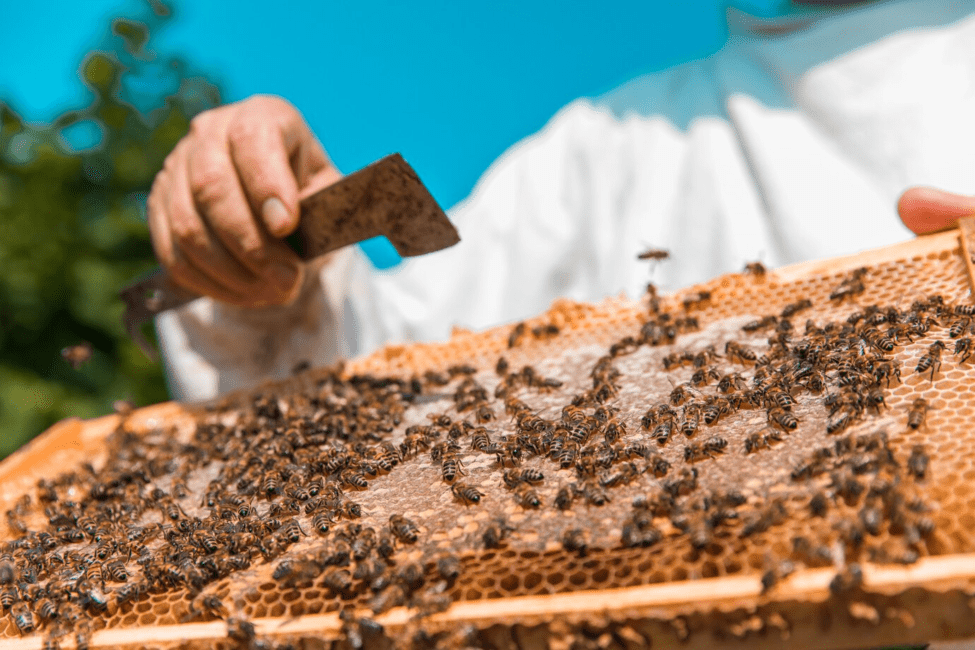This is a sponsored post…
Backyard beekeeping, also known as urban beekeeping or hobby beekeeping, refers to the practice of maintaining and caring for bee colonies in a beekeeper’s backyard or garden, primarily in urban or suburban settings.
This practice allows individuals to produce honey, wax, and other bee products for personal use, sale, or sharing. It also contributes to pollinating local plants and flowers, enhancing garden health and biodiversity.
It’s a remarkably safe and rewarding activity as long as it’s practiced responsibly and with an informed approach. It hinges on several crucial factors for a harmonious coexistence between bees, beekeepers, and the surrounding community. Let’s check them out here.
Backyard Beekeeping Knowledge, Equipment, and Best Practices
Equipping yourself with the right knowledge and bee supplies is essential for safe beekeeping. First, education and comprehensive research on bee behavior, hive management, and disease control are necessary.
Many local communities offer courses or workshops for aspiring beekeepers, which can provide valuable hands-on experience and advice from seasoned experts. For online courses, consider the following reputable resources:
- University of Colorado Boulder’s Introduction to Bookkeeping
- Penn State Extension Beekeeping Courses
- Beekeeper’s University (by the Michigan State University Extension)
- University of Montana’s Online Beekeeping Certificate Program
- Cornell University’s Master Beekeeper Program
Second, proper protective gear, such as a bee suit, gloves, and a veil, is crucial to minimize the risk of stings. Note that while bee stings are a natural part of beekeeping, understanding how to handle bees gently and calmly can significantly reduce their frequency.
Lastly, best practices should be implemented to help prevent issues that could lead to aggressive bee behavior or hive diseases. They’re crucial for the well-being of the bees, the beekeeper, and the surrounding community.
These are typically discussed and practiced in beekeeping classes or workshops. For an overview, here are some of the best beekeeping practices to learn to ensure a healthy and productive beekeeping experience:
- Regular Hive Inspections – for early detection of issues, allowing timely interventions to keep the colony healthy and productive
- Pest and Disease Management – for preventing outbreaks that can decimate bee populations and affect local agriculture and ecosystems
- Providing Adequate Space and Resources – for supporting the natural growth and sustainability of the colony, reducing stress and competition within the hive
- Swarm Prevention and Management – for maintaining colony strength and minimizing the risk of bees establishing hives in unwanted areas, promoting harmony in urban and suburban settings
- Continuous Education and Training – key to adapting to changing environmental conditions and challenges, ensuring beekeepers can apply the best practices for the welfare of their bees
Read Also: Are Honey Bees Aggressive?
Environmental Considerations and Hive Placement

Choosing the right location for your hive plays a significant role in safety. Hives should be placed in quiet, low-traffic areas of your yard, ideally with a barrier such as a fence or shrubbery to encourage bees to fly upward and reduce interactions with people and pets.
Ensuring access to ample forage, including flowers, trees, and water, supports the health of your bees as well. This also reduces their need to venture far from the hive, which can decrease the likelihood of negative encounters.
Additionally, it’s important to understand and support the local ecosystem. However, note that introducing bees into an environment where they can thrive without disrupting native pollinators requires careful consideration.
This should involve implementing practices such as planting diverse bee-friendly flora and avoiding pesticides. They can contribute to a safe and sustainable beekeeping operation that benefits the broader ecosystem.
Legal Considerations and Community Relations
It’s also important to investigate local laws and ordinances governing beekeeping in your area. Many municipalities have specific regulations that dictate how and where hives can be kept.
These may include restrictions on the number of hives, required distances from property lines, and measures to prevent bees from becoming a nuisance to neighbors. Adhering to these laws not only ensures legal compliance but also promotes good relations within the community.
Communicating with your neighbors is another critical aspect of backyard beekeeping. Always indulge in open dialogue to help alleviate concerns and misconceptions about bees. Consider sharing harvested honey or inviting neighbors to learn more about beekeeping to foster a positive atmosphere and reduce potential conflicts.
Emergency Preparedness and Risk Management
Despite preventive measures, beekeepers and those nearby may face bee stings, with reactions ranging from mild to severe, including the risk of anaphylaxis. In such cases, it’s important for beekeepers to know how to take proactive steps, such as promptly removing the stinger, cleaning the wound, and using cold packs to reduce swelling.
For severe allergic reactions, it’s also worth considering having an epinephrine auto-injector like an EpiPen on hand for immediate treatment.
When hives display unusually aggressive tendencies or pose direct threats to public safety, beekeepers must understand and implement strategies like re-queening or consulting with professional bee removal experts for hive relocation to mitigate risks. This helps ensure the safety of both the beekeeping community and the public while preserving the bee colonies’ well-being.
Final Thoughts
Beekeeping is generally a safe activity. However, its safety largely depends on the beekeeper’s commitment to education, preparedness, legal compliance, community and environment consideration, and responsible management. That’s why it’s essential to continue learning and staying up-to-date with best practices, local regulations, and potential risks.
With the right knowledge and resources, anyone can have a fulfilling and rewarding beekeeping experience while promoting the health of our precious pollinators.
Read Also: Agricultural Waste Generation Sources and Characteristics

